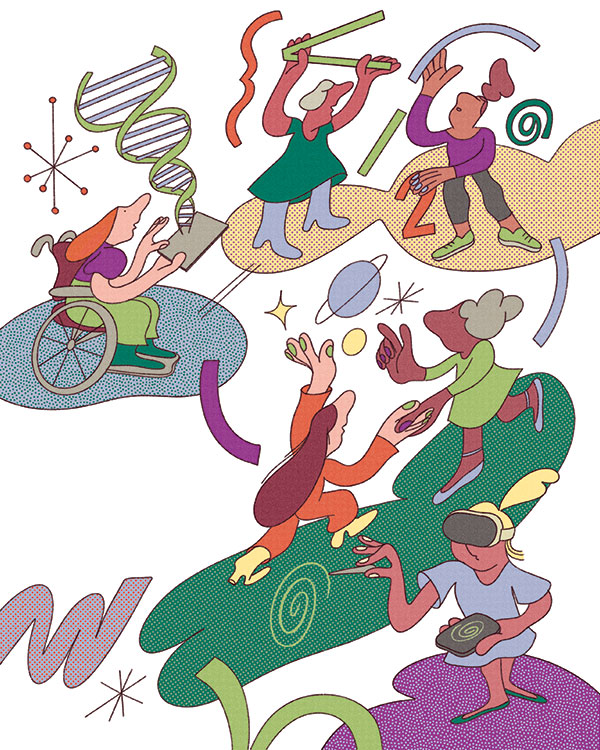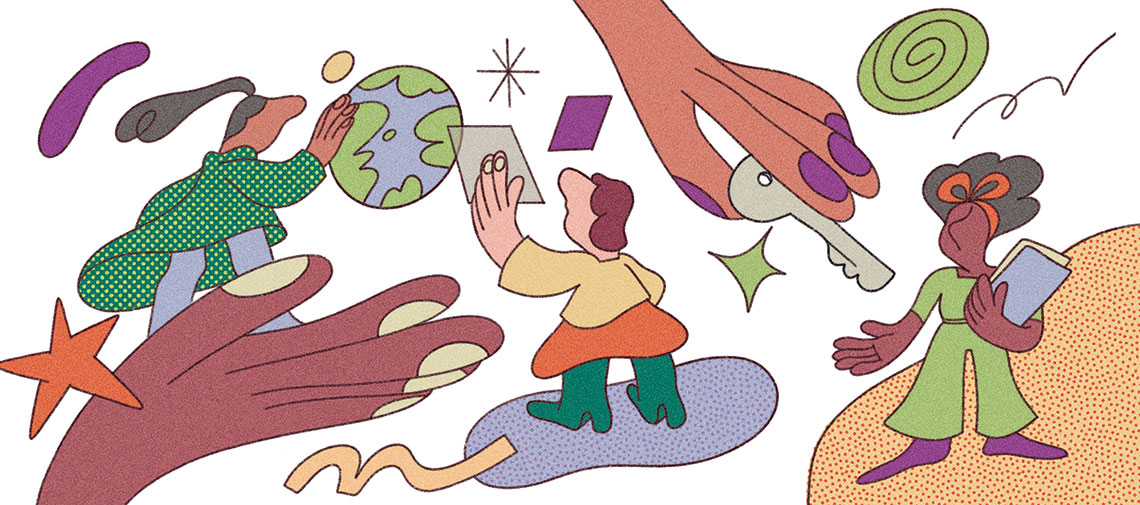Only 31% of international patent applications contained a woman’s name in the application team in 2020, according to data from the report “The global gender gap in innovation and creativity,” published this year by the World International Property Organization (WIPO). It is true that this overview has been improving—in 2005, the proportion was much less, at 20%. If the growth rate continues, gender equity will only be reached in 2061, but this is unlikely to happen while women continue to be the clear minority in some careers linked to engineering and computer science, from which part of the inventors and professionals that create innovations come from. A series of initiatives in Brazil captained by women is trying to strengthen the female presence in innovative entrepreneurship and in the protection of intellectual property.
The National Association of Entities Promoting Innovative Enterprises (ANPROTEC) last year joined the Female Sci-Tech Talent Capacity Building Center, a platform created in Beijing, China, to increase female participation in the so-called STEM careers (sciences, technology, engineering, and math) and in technology-based innovation. The initiative counts on members from several countries, such as Canada, Croatia, Portugal, and South Africa. In Brazil, one of the first actions proposed is the construction of a female talent network responsible for supporting inventors and entrepreneurs, organizing events and establishing channels with groups from other countries—the idea is to demystify concepts of innovation and attract participation from more women. ANPROTEC closed the registration for the selection process last month, the results of which should be out soon, to select 10 professionals from companies and institutions linked to the innovation ecosystem entrusted to set up this network. “The main challenge is creating more equal opportunities and promoting the engagement of women in technological enterprises,” states Rosana Jamal Fernandes, director of companies at ANPROTEC, who heads the initiative. She is one of the founding partners of the Baita startup accelerator, in Campinas. “It is necessary to invest more in the participation of women in STEM careers and in innovative companies.”
Other institutions are moving in the same direction. The National Institute of Industrial Property (INPI), a federal entity responsible for the registry and concession of brands, patents, software, and industrial designs, among other things, has recently created the Strategic Committee for Gender, Diversity, and Inclusion, with the aim of implementing policies that increase the participation of minority groups, such as women and Black people, among those that register patent applications or work with intellectual property protection in Brazil (see table).
The engagement of women in patenting activities is greater in life sciences, a career in which there is a marked female presence
The Oswaldo Cruz Foundation (FIOCRUZ), in Rio de Janeiro, is producing a study, which should be ready in 2024, about gender issues related to the institution’s registration of patents. “We are doing an in-depth analysis, since there is a lack of information and statistics related to the theme,” says Carla Maia, Technological Management coordinator at FIOCRUZ. “The idea is to promote initiatives aimed at the foundation’s female inventors and encourage greater participation by women in innovation,” she adds. A biology and biomedicine graduate, Maia has already worked at the INPI and the Brazilian Development Association (ABDE), an entity dedicated to sustainable economic, social, and environmental development. She has worked at FIOCRUZ since 2012 as an innovation management analyst and assumed the role of coordinator five years ago. “It is not a common trajectory in the world of women who work in areas of technology and science,” she says, referring to the strong male presence in management positions. “I was lucky to have had really good bosses, men and women, who gave me opportunities. We need to promote this type of egalitarian environment in more organizations.”
Physician Patricia Veras is one of the FIOCRUZ researchers who has already submitted a patent application to INPI: in 2020, she applied to register a new treatment for cutaneous leishmaniasis, a disease caused by a protozoa. She tested, in the foundation’s laboratories, a molecule discovered by the National Cancer Institute, in the USA, with properties for treating tumors and parasites. “We decided to analyze the efficacy of the molecule against leishmaniasis, a disease that affects a neglected population and is present in over 80 countries, and the results were satisfactory,” says Veras. The technology is in the laboratory test phase and the intention is to transfer it to an interested pharmaceutical company.
Gender disparities in activities linked to innovation are a known phenomenon. Several studies show that the participation of women is more frequent in patents presented by groups than in applications made by a single inventor and it is easier to find a female name on registrations obtained by public institutions than by companies — proof that they find friendlier environments in teams and in academia. A study published in 2020, which correlated patents and gender in 11 Latin American countries, found that female engagement in patenting activities is greater in life sciences, a field in which women have a strong presence in scientific careers (see Pesquisa FAPESP issue nº 298).
 Paola Saliby
Paola Saliby
“The process of filing a patent is complex and slow. The major bottleneck is in the transfer of technology, which is taking the discovery to the market,” says chemical engineer Adriana Faria, executive director of the Viçosa Technological Park, of the Federal University of Viçosa, in Minas Gerais. According to her, knowledge of dealing with financial risks and years of dedication to a project are required. “On this career path, it is more common to see men than women, because the women often need to deal with double or triple working hours and they are mothers,” she asserts. Faria says the she has always encountered brilliant women in STEM careers throughout her professional trajectory. “But many end up not being able to develop due to questions that involve the difficulty of traveling for work or study due to having children to look after,” says the married mother of two. In her view, it is a global reality. “It is not so different in other countries, and maybe that is why global initiatives are appearing to promote the insertion of women in entrepreneurship,” says the engineer, a teacher on the master’s program in Technological Innovation and Intellectual Property at the Federal University of Minas Gerais.
In March, the 1st International Seminar of Women in Intellectual Property was held at the headquarters of the Brazilian Intellectual Property Association (ABPI), in Rio de Janeiro. The event was organized by PI Female, a group created in 2019 by female entrepreneur Jussiane Siqueira, of Inomapi Inovação em Propriedade Intelectual, a company dedicated to patent registration. Founded to stimulate exchanges of experiences and to strengthen inclusion in the sector, the group, which functions via WhatsApp, contains over 300 women today, twice as many as when it began. “Lots of women graduate from university and end up becoming employees of offices specialized in patents. It is important to expand this female presence in innovative companies and in leadership roles,” reflects Siqueira. PI Female has been preparing actions such as the launch of a mentoring program for women that want to become entrepreneurs or work in the area of intellectual property, planned for this year. “A culture change is necessary,” she explains.
The academic environment has been encouraging female participation in entrepreneurship and in technological innovation. In São Paulo, INSPER, a private teaching and research institution with courses in areas of economics, business administration, law, engineering, and computer science, launched the Women in Tech program at the end of 2021, which promoted leadership training for female researchers, entrepreneurs, and STEM career professionals, in partnership with the British Council, which had participation of around 60 women. The initiative has also already offered more than 30 scholarships to high school students for courses at INSPER in innovation and topics linked to technology during the July holidays. This year, a mentoring program for women should be created for leadership roles in technology-related careers. “We need to advance more in the promotion of equality in areas of science and in entrepreneurship, since these areas still have a much higher male presence,” says Carolina Fouad, project manager of the INSPER Innovation Hub, responsible for the creation of the Women in Tech program. She mentions a SEBRAE survey, according to which women are owners of only 34.4% of the existing businesses in the country. “Promoting diversity will bring benefits to society and to the country,” she states.
The National Institute of Industrial Property (INPI) published a study in May about aspects of the ethnicity and gender of the users of its services, based on online questionnaires responded by a sample of 139 individuals that includes, for example, people that have some type of asset deposited at the institution or have attended courses on intellectual property that it offers. In relation to gender, 57% were men and 40% women, while 2% did not respond and 1% declared themselves as nonbinary. Seventy-nine percent declared themselves as cisgender, meaning they identified themselves with the gender designated at birth, 21% did not respond, and nobody said they were transgender. In relation to ethnic origin, 71% self-declared as white, 21% as Black and mixed race, 1% as Asian, and 8% did not respond.
Cross-referencing of the results shows that the main group of users of the INPI system, equivalent to 40%, is made up of white men. The study also analyzed the workplace of the respondents and concluded that women surpass men among the professionals that work in large companies, those with over 500 employees. Women are also concentrated in legal departments. Few Black women took part in the study and, in general, they work with intellectual property in public institutions.
The study was promoted by the General Coordination for the Development of Industrial Property, Business, and Innovation of the INPI and will be used to propose strategies and public policies to increase inclusion in the intellectual property system. The institute also intends to gather more comprehensive data and establish a network of statistical analysis to monitor the profile of the users. “Patent offices in many countries are engaged in increasing diversity in the intellectual property system, to make it more inclusive and efficient,” explains Rafaela Di Sabato Guerrante, researcher at INPI and coordinator of the institution’s Strategic Committee for Gender, Diversity, and Inclusion, created in 2022. “The study that collected ethnic and gender profiles is a first step towards spreading our actions with publics that today are minorities and propose initiatives for training and mentoring in intellectual property aimed at women and Black people,” she says.


